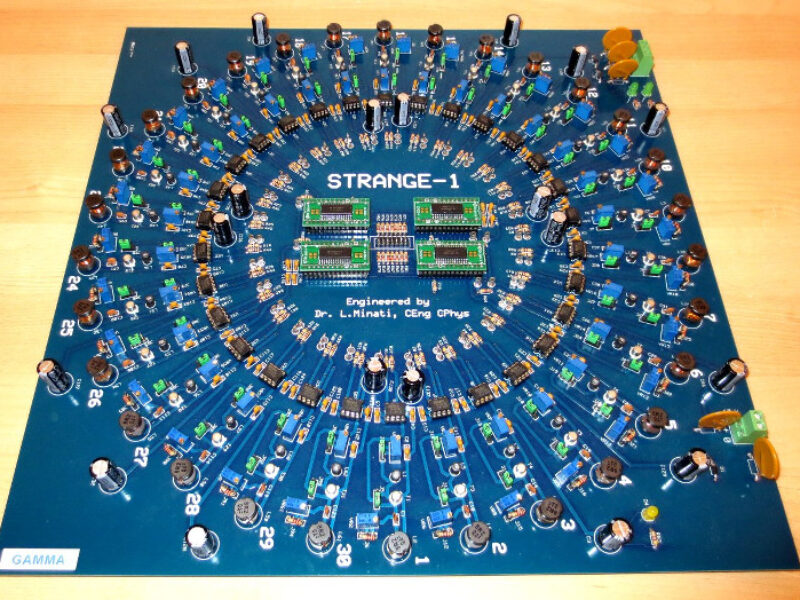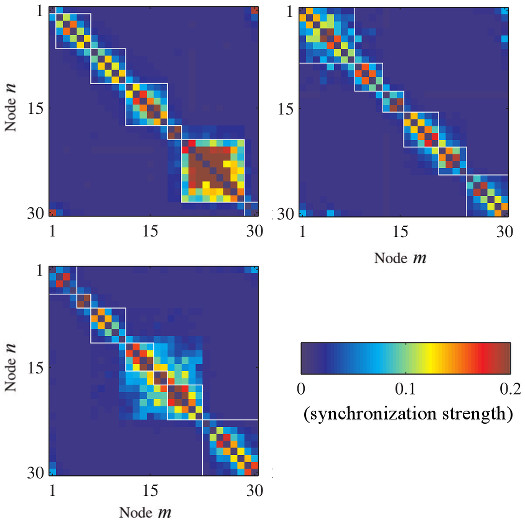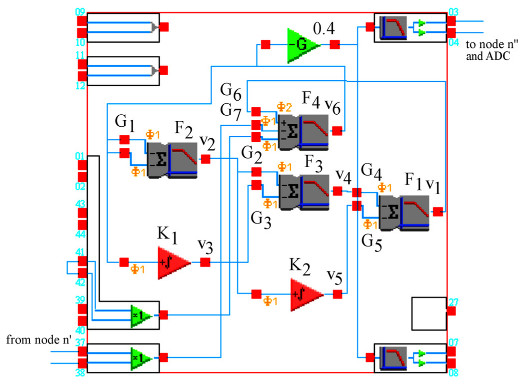
Chaotic circuits can mimic brain function, aid computing
There is striking dynamical complexity that is readily accessible with networks of even the simplest analog circuits, so long as they are non-linear.
A fundamental characteristic of brains is that their capabilities are mostly not hardwired by design, but reflect self-organization: brain networks possess so-called emergent properties that cannot be easily inferred from their separate constituent elements. The possibility to engineer a similar approach electronically would likely boost the ability of neuromorphic systems to solve classification and control tasks in a highly size- and energy-efficient manner, with practical implications for both embedded and large-scale computing. However, engineering self-organization remains difficult: leaping from neuromorphic computation by design – amply explored over the past decades – to neuromorphic computation by emergence may look like an insurmountable challenge.
Yet the ability to self-organize is far from unique to networks of neurons and may also be exhibited by elementary electronic oscillators. It is easy to build networks of oscillators that synchronize in patterns not trivially related to their connectivity, and that change dynamically depending on specific settings or inputs. Because this phenomenon can be readily observed even with elementary oscillators, it is possible to implement large networks that, at least in principle, may harbour huge computational capabilities. To stimulate work in this direction, my recent research has explored emergent phenomena through building a diverse set of oscillators including single-transistor circuits [references 1 to 3], CMOS inverter-rings [4], gas discharge tube circuits [5] and field-programmable analog arrays (FPAAs) [6].
Next: A strange board
For example, one can realize a ring network, wherein each of the 30 nodes is a single-transistor chaotic oscillator comprising only 5 discrete components, and is resistively coupled to its neighbours (Fig. 1, Fig. 2). The circuits can be tuned to oscillate chaotically, in other words, to retain deterministic dynamics but operate in such manner than small fluctuations are rapidly amplified in time [1].

Fig. 1. Elementary single-transistor oscillator, which can be tuned for periodic or chaotic dynamics by varying R1 (Reproduced from [2]).

Fig. 2. The STRANGE-1 board, implementing a ring of 30 single-transistor oscillators, resistively coupled to their neighbours (Reproduced from [2]).
As put by Edward Lorenz: “Chaos: When the present determines the future, but the approximate present does not approximately determine the future.” The resulting signals are not at all random, but have a very complex geometric structure that is characteristic of each oscillator; this, for example, may appear as spikes of variable amplitude (Fig. 3).
Next: Spiking waveform

Fig. 3. Example of spiking chaotic waveform: the spike amplitudes do not vary randomly, but follow a complex deterministic pattern (Reproduced from [1]).
An interesting phenomenon is that if the oscillators are coupled with intermediate strength, they spontaneously form communities of units that preferentially synchronize with one another (Fig. 4).

Fig. 4. Example of spontaneous community formation (cluster synchronization) by oscillators coupled in a ring; the three matrices represent different sets of components, with associated tolerances (Adapted from [2]).
The phenomenon, known as cluster synchronization, is seemingly arbitrary, but is ultimately driven in a deterministic manner by the effect that tolerances in component values have on the circuit behaviours [2]. Remarkably, there is evidence of similar phenomena in the brain, which may be the ultimate origin of the modular organization that we observe among its areas [3].
Next: Remote synchronization
An even more exotic phenomenon that can be observed is remote synchronization: pairs or groups of oscillators that are connected through one or more other oscillators become synchronized, seemingly without entraining the intermediate oscillator(s). For example if A-B and B-C are connected, A-C may become synchronized, but not synchronized with B. This phenomenon, like many others in this area, only arises when the oscillators are chaotic, or close to the point of order-to-chaos transition. It also requires them to be non-identical in terms of component parameters, which is the usual scenario in biology. Physicists have known this for some time, but its relevance to brain function has only been realized recently. To study this phenomenon, an oscillator was implemented in an FPAA that could be tuned digitally to operate in different regimes (Fig. 5).

Fig. 5. The ring-oscillator circuit with overlaid integrators implemented in a Field-Progammable Analog Array (FPAA, Reproduced from [5]).
When enough oscillators are coupled in a ring, and the parameters are tuned so they are collectively in an intermediate state between periodic and chaotic oscillation, remote synchronization patterns appear. These patterns contain a lot more structure than the elementary ring according to which the oscillators are physically wired together (Fig. 6, Fig. 7).

Fig. 6. The complex synchronization patterns that are formed, simply starting from 32 oscillators connected in a ring; the three matrices represent different parameter settings (Adapted from [5]).
Next: Spiking and computing

Fig. 7. An example of remote synchronization: moving away from a node, activity is initially synchronized with it, then becomes non-synchronized, then for even larger distance it is synchronized again (Adapted from [5]).
More specifically, they feature so-called “small-world” properties, which are closely linked to the way brain regions are organized. Remote synchronization is as yet poorly understood, but a substantial amount of experimental data and the design of a dedicated board (Fig. 8) have been released open-source [5].

Fig. 8. The LYAPUNOV-1 board implementing a reconfigurable FPAA network, effectively an analog computer to plug into a conventional one (Reproduced from [5]).
Another example is the phenomenon of avalanching, which governs the way groups of neurons discharge. Many natural systems can avalanche. These include: sand piles and solids close to the point of fracturing, such as can be found in earthquakes. A striking fact is that the size and duration of the avalanches usually follow power-law distributions, the exponents of which are not arbitrary but define a small number of so-called “universality classes.” This is related to the notion of self-organized criticality, meaning the dynamics of many systems are inherently drawn close to the point of transition between order and chaos, which has been one of the most influential physical discoveries in the last century.
Next: Making an avalanche
To demonstrate avalanching in an elementary electronic circuit, we devised an array of glow lamps, each one coupled to its four neighbours via capacitors and to a global DC voltage via a resistor (Fig. 9)

Fig. 9. The avalanching circuit based on glow lamps coupled in a lattice by capacitors (Reproduced from [6]).
As the voltage is increased close to the striking voltage of the lamps, avalanches of flashes involving distant lamps appear (Fig. 10).

Fig. 10. An example of avalanche behavior involving several distant sites, with a distribution that follows “universal” scaling exponents.
Their distributions of size and duration follow power-laws with exponents 3/2 and 2. Remarkably these are the same power-law exponents observed for avalanches of neural spikes in the brain, even though in this case, the system is externally tuned. As the circuit is simple, this result provides a good example of emergence of interesting properties that one cannot easily infer a-priori in networks of non-linear analog circuits. Also in this case, experimental data and design materials have been released publicly [6].
Even though at present such circuits may appear mostly as an academic matter, the key lies in becoming able to perform useful computations with them. There is no hard theoretical reason this cannot be possible.
For example, non-linear dynamics leading to the formation of prescribed patterns could lead to sensor arrays where clustering behaviour could be used for data reduction within the array itself. This would entail developing elements, such as pixels, whose non-linear dynamics are suitably influenced by the inputs to make them synchronize in a desired manner in response to them.
Next: More opportunities
Remote synchronization, on the other hand, may have practical relevance to secure communications, an area that has recently seen a resurgence of interest in chaotic oscillators. This would require understanding exactly how “hidden information transfer” takes place, such that some nodes can synchronized via others without seemingly entraining them, and how the phenomenon can be replicated in distributed telecommunication networks.
Further, networks of non-linear oscillators operating in the gigahertz region can be devised, and could find application in the generation and decoding of high-entropy, broadband radio signals. Microwave-range chaotic oscillators have been demonstrated and chaotic signals are inherently broadband. Therefore, one could, for example, devise small networks of different chaotic oscillators which generate a signal that, when fed to a remote network of the same oscillators, leads to a certain synchronization pattern.
Chaotic circuits are fertile ground for further R&D and for an evolution from academic study towards the increased discovery and demonstration of commercial applications.
Ludovico Minati is a freelance researcher based in northeast Italy. He is presently also visiting professor at the Complex Systems Theory Department of the Institute of Nuclear Physics – Polish Academy of Science, Kraków, Poland, and guest fellow of the Centre for Mind/Brain Science (CIMeC) of the University of Trento, Italy. He can be contacted at lminati@ieee.org, ludovico.minati@ifj.edu.pl, ludovico.minati@unitn.it.
Related links:
[1] Minati L. Experimental dynamical characterization of five autonomous chaotic oscillators with tunable series resistance. Chaos 2014; 24(3):033110, https://scitation.aip.org/content/aip/journal/chaos/24/3/10.1063/1.4890530
[2] Minati L. Experimental synchronization of chaos in a large ring of mutually coupled single-transistor oscillators: phase, amplitude, and clustering effects. Chaos 2014; 24(4):043108, https://scitation.aip.org/content/aip/journal/chaos/24/4/10.1063/1.4896815
[3] Minati L, Chiesa P, Tabarelli D, D’Incerti L, Jovicich J. Synchronization, non-linear dynamics and low-frequency fluctuations: analogy between spontaneous brain activity and networked single-transistor chaotic oscillators. Chaos 2015; 25(3):033107, https://scitation.aip.org/content/aip/journal/chaos/25/3/10.1063/1.4914938
[4] Minati L. Experimental Implementation of Networked Chaotic Oscillators Based on Cross-Coupled Inverter Rings in a CMOS Integrated Circuit. J Circuit Syst Comp 2015; 24:1550144, https://www.worldscientific.com/doi/abs/10.1142/S0218126615501443
[5] Minati L. Remote synchronization of amplitudes across an experimental ring of non-linear oscillators. Chaos 2015; 25(12):123107, https://scitation.aip.org/content/aip/journal/chaos/25/12/10.1063/1.4936791
[6] Minati L, De Candia A, Scarpetta S. Critical phenomena at a first-order phase transition in a lattice of glow lamps: Experimental findings and analogy to neural activity. Chaos 2016; 26(7): 073103 https://scitation.aip.org/content/aip/journal/chaos/26/7/10.1063/1.4954879
 If you enjoyed this article, you will like the following ones: don't miss them by subscribing to :
eeNews on Google News
If you enjoyed this article, you will like the following ones: don't miss them by subscribing to :
eeNews on Google News



